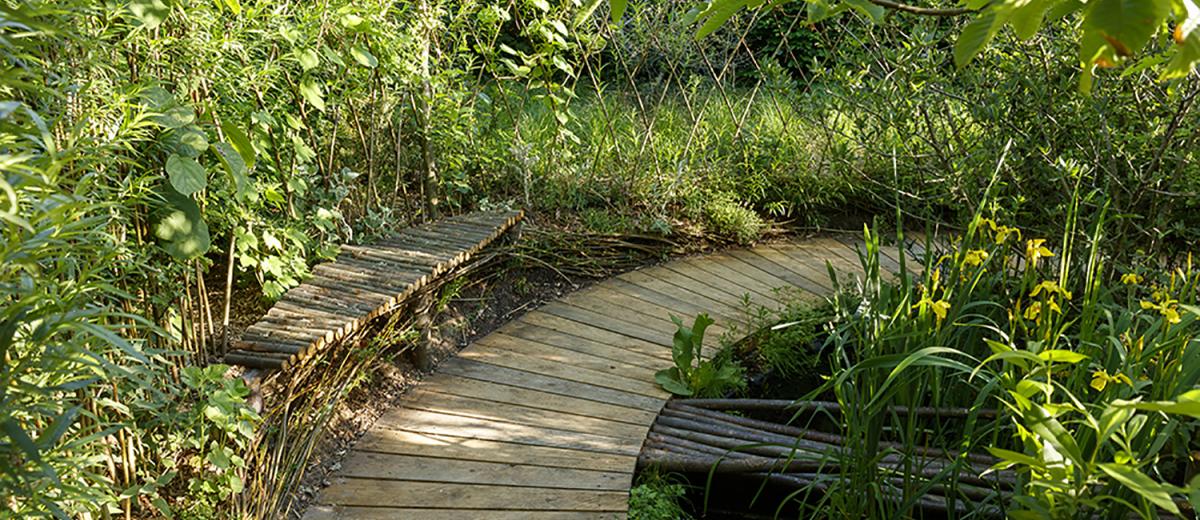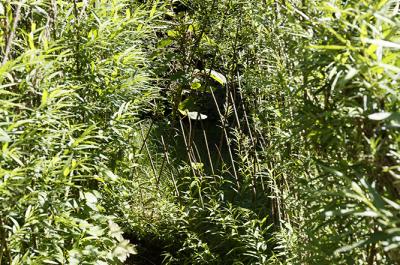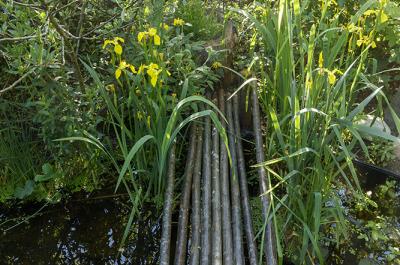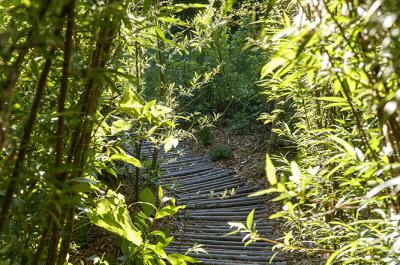07. On récolte ce que l’on sème
Awarded on the 23rd of June 2020 by a jury of professionals renowned in the world of garden art

In this space, the farmer is first placed in opposition to unspoilt nature, before finding a sort of reconciliation. Wide open fields are often planted with a single crop, whereas nature tends to set out a wide range of useful and nourishing species all at once. The former is represented by furrows ploughed into bare earth, while the latter is made up of living willow woven together and covered with climbing plants. However, in a third area, the shapes and colours unite to offer different habitats with fleeting lights and sounds. Staffs of life with red bark are placed in basins; they are full of seeds and invite visitors to sow them among the surrounding trees, shrubs and perennials. Untamed nature remains luxuriant, humming with the sound of its bees and birds. Each seed is a future gift for humanity. Chestnuts, willow, garlic, squashes and elder are soon intermingled among the cereals. The earth comes back to life. The fields prosper once again.
DESIGNERS

A Parisian by birth, Baptiste Gérard-Hirne grew up on a houseboat, rocked by the current of the Seine. He therefore enjoyed a natural environment with urban influences. Since high school he has been interested in exploring abandoned places and finding different ways to engage with the landscape. Having taken the science stream in the baccalaureate, he took a vocational qualification in landscaping and developed a technical approach to landscape design. Here he honed his horticultural knowledge and practical skills, working both in town gardens and in the countryside. He then enrolled in the French School of Landscape Design in Versailles where he learned the various stages of a landscape design project, from small-scale urban designs to large-scale rural ones. Out of curiosity he left for Mexico for a work placement and began to become more interested in food producing landscapes and cooking. He soon started taking on gardening projects, either alone or with others, and began providing a complete design and build landscaping service. He also became an active member of the Green Resistance movement and broadened his skills. Driven by sustainable growing methods, he works with a multidisciplinary team to create living displays for events and cultural sites. As a young graduate, he is now starting freelance work on various projects. His graduation project was on the Colline Rodin, a brownfield site high up above a chalk quarry. He takes part in community projects such as those in the Bassin Minier in Lens or on the abandoned Petite Ceinture railway in Paris. He also responds to calls for tender involving displays, gardens and art installations. He is now trying to direct his career as a landscape designer towards creating edible gardens in public places for voluntary associations or for private estates that are trying to develop sustainable designs.
The granddaughter of farmers in Alençon in Normandy, Emma Morillon has a passion for the landscape, and more specifically for wide open landscapes, a passion that comes from working the soil. Working, in the sense of transforming, protecting and reinventing the space. During her many experiences abroad, studying in Versailles, Edinburgh and Amsterdam, she has experimented with different ways of approaching landscaping projects as a designer, artist or a practical landscaper. She is also a musician and music is found in many of her works as she incorporates musical composition as a new way of analysing a site. This work starts with a piece of music Blue to grey song which takes its inspiration from a trip to Noordoostpolder in the Netherlands. She moved to Brussels in October 2019 to work at the crossroads between the countries where she has lived. She is gradually sowing her ideas about a return to nature in new places that have been tamed by people.
Philippe Allignet grew up between the Creuse valley and greater Paris. He is passionate about gardens and, more generally, the processes at work in our landscapes. Having gained a vocational qualification in landscaping, he studied at the School of Nature and Landscape in Blois and then at the Academy of Architecture in Amsterdam, where he is again studying today. After a short time at Atelier Jacqueline Osty & Associés where he developed a certain fascination for “urban things”, he then worked at H+N+S+ Landschapsarchitecten (The Netherlands). Working in this practice specialising in large-scale landscaping led to a fascination with our landscapes and the tensions between natural, ecological processes and the uses to which mankind and our societies want to put them. He is now sure that, due to climate breakdown and ecological decline, all stakeholders and those who make decisions about land use must make profound changes to safeguard the future. But he is a realist, and with this in mind he is now writing a Masters’ thesis on the regeneration of France's fragile urban framework of middle-sized towns, and in particular on Vierzon and how regeneration can be initiated by the landscape. As an idealist, he is also convinced that changing the habits, outlook and expectations of every citizen is a fundamental challenge for the future. Contemporary agriculture is one cog where change is necessary. What could be better than a garden to express this idea, to raise awareness and change people’s habits?



